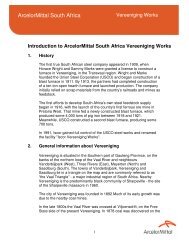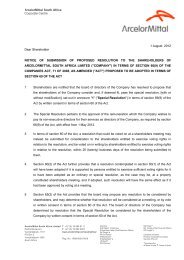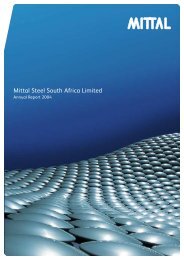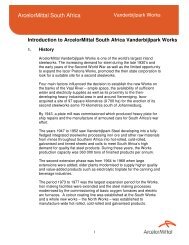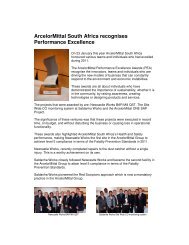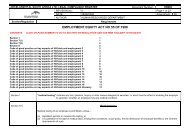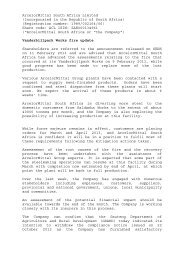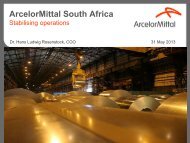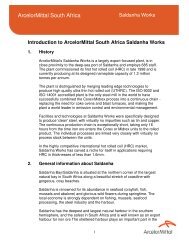Rebuilding profitability and mitigating risk - ArcelorMittal South Africa
Rebuilding profitability and mitigating risk - ArcelorMittal South Africa
Rebuilding profitability and mitigating risk - ArcelorMittal South Africa
You also want an ePaper? Increase the reach of your titles
YUMPU automatically turns print PDFs into web optimized ePapers that Google loves.
<strong>ArcelorMittal</strong> <strong>South</strong> <strong>Africa</strong><br />
<strong>Rebuilding</strong> <strong>profitability</strong> <strong>and</strong> <strong>mitigating</strong> <strong>risk</strong><br />
Matthias Wellhausen, CFO 31 May 2013
Disclaimer<br />
Forward-Looking Statements<br />
This presentation may contain forward-looking information <strong>and</strong> statements about<br />
<strong>ArcelorMittal</strong> <strong>South</strong> <strong>Africa</strong> <strong>and</strong> its subsidiaries. These statements include financial<br />
projections <strong>and</strong> estimates <strong>and</strong> their underlying assumptions, statements regarding plans,<br />
objectives <strong>and</strong> expectations with respect to future operations, products <strong>and</strong> services, <strong>and</strong><br />
statements regarding future performance. Forward-looking statements may be identified by<br />
the words “believe,” “expect,” “anticipate,” “target” or similar expressions. Although<br />
<strong>ArcelorMittal</strong> <strong>South</strong> <strong>Africa</strong>’s management believes that the expectations reflected in such<br />
forward-looking statements are reasonable, investors <strong>and</strong> holders of <strong>ArcelorMittal</strong> <strong>South</strong><br />
<strong>Africa</strong>’s securities are cautioned that forward-looking information <strong>and</strong> statements are<br />
subject to numerous <strong>risk</strong>s <strong>and</strong> uncertainties, many of which are difficult to predict <strong>and</strong><br />
generally beyond the control of <strong>ArcelorMittal</strong> <strong>South</strong> <strong>Africa</strong>, that could cause actual results<br />
<strong>and</strong> developments to differ materially <strong>and</strong> adversely from those expressed in, or implied or<br />
projected by, the forward-looking information <strong>and</strong> statements. These <strong>risk</strong>s <strong>and</strong> uncertainties<br />
include those discussed or identified in the filings with the JSE made or to be made by<br />
<strong>ArcelorMittal</strong> <strong>South</strong> <strong>Africa</strong>, including <strong>ArcelorMittal</strong> <strong>South</strong> <strong>Africa</strong>’s Annual Report for the year<br />
ended December 31, 2012 filed with the JSE. These forward looking statements have not<br />
been reviewed <strong>and</strong> reported on by <strong>ArcelorMittal</strong> <strong>South</strong> <strong>Africa</strong>’s auditors <strong>and</strong> apply only as of<br />
the date they are made. <strong>ArcelorMittal</strong> <strong>South</strong> <strong>Africa</strong> undertakes no obligation to publicly<br />
update its forward-looking statements, whether as a result of new information, future events,<br />
or otherwise.<br />
1
Agenda<br />
• Financial performance<br />
• Cost pressures impacting business<br />
• Actions to improve margins<br />
• Medium term <strong>profitability</strong> target of $100/t EBITDA<br />
• Risk management processes<br />
• Key messages<br />
2
Financial performance<br />
• Weak financial performance post crisis<br />
• Volumes have remained stable<br />
• Despite price recovery steel margins<br />
deteriorating primarily due to higher<br />
costs<br />
Challenging costs<br />
<strong>ArcelorMittal</strong> <strong>South</strong> <strong>Africa</strong> EBITDA ($/t)<br />
93<br />
53<br />
41<br />
31<br />
2009 2010<br />
2011<br />
2012<br />
EBITDA bridge between 2009-2012 ($m)<br />
717<br />
815<br />
Productivity<br />
198<br />
24<br />
19<br />
143<br />
EBITDA<br />
2009<br />
Vol<br />
Price<br />
Cost<br />
Non<br />
steel<br />
EBITDA<br />
2012<br />
3
2000/01<br />
2000/04<br />
2001/03<br />
2002/02<br />
2003/01<br />
2003/04<br />
2004/03<br />
2005/02<br />
2006/01<br />
2006/04<br />
2007/03<br />
2008/02<br />
2009/01<br />
2009/04<br />
2010/03<br />
2011/02<br />
2012/01<br />
2012/03<br />
Strengthening currency <strong>and</strong> inflationary<br />
pressures have impacted competitiveness<br />
Unit labour cost increasing post crisis above<br />
productivity<br />
Strengthening exchange rate during 2010 <strong>and</strong> 2011<br />
surge on electricity cost<br />
200<br />
190<br />
180<br />
170<br />
160<br />
150<br />
140<br />
130<br />
120<br />
110<br />
100<br />
90<br />
Labour unit cost (Manufacturing)<br />
Labour Productivity (Manufacturing)<br />
Electricity price index<br />
R/$ exchange rate index<br />
340<br />
130<br />
320<br />
300<br />
125<br />
280<br />
260<br />
120<br />
240<br />
220<br />
115<br />
200<br />
180<br />
110<br />
160<br />
140<br />
105<br />
120<br />
100<br />
100<br />
2006 2007 2008 2009 2010 2011 2012<br />
Source: Reservebank <strong>South</strong> <strong>Africa</strong>. Unit labor cost index in R<strong>and</strong><br />
4
Raw material increases <strong>and</strong> incidents<br />
have driven costs higher<br />
Major incidents have increased fixed costs <strong>and</strong> reduced<br />
efficiencies<br />
6,400<br />
6,200<br />
6,000<br />
5,800<br />
5,600<br />
5,400<br />
Saldanha<br />
Corex burn<br />
Saldanha bin<br />
collapse, BF<br />
VDP &<br />
Newcastle<br />
Newcastle dust<br />
catcher,<br />
BF VDP &<br />
Newcastle<br />
Impact of major<br />
incidents since 2009<br />
cause lost opportunity<br />
Newcastle<br />
taphole repair,<br />
VDP BF burn<br />
through<br />
VDP<br />
BOF fire<br />
140<br />
120<br />
100<br />
80<br />
60<br />
Raw material benefit diluted with decreasing<br />
international prices<br />
240<br />
220<br />
200<br />
180<br />
160<br />
5,200<br />
40<br />
140<br />
5,000<br />
20<br />
120<br />
0<br />
2009 2010<br />
Major incidents<br />
Liquid steel production<br />
Fixed cost $/t<br />
2011<br />
2012<br />
2013F<br />
0<br />
100<br />
2006 2007 2008 2009 2010 2011 2012 2013<br />
YTD<br />
AMSA RM index (Iron ore, coal, scrap) (Base 100 = 2006)<br />
International RM basket index (Base = 100)<br />
5
Improving performance challenges<br />
remain at V<strong>and</strong>erbijlpark<br />
• Solid progress at Saldanha,<br />
Newcastle <strong>and</strong> Vereeniging<br />
• Reline of blast furnace 5 will further<br />
improve efficiencies at Newcastle<br />
• Ongoing V<strong>and</strong>erbijlpark concerns:<br />
‣ Exposure to escalating costs of<br />
Thabazimbi ore & Tshikondeni<br />
coal<br />
‣ Efficiencies to be improved<br />
‣ Underutilization of downstream<br />
operations<br />
‣ Off-gas utilization potential<br />
‣ Weak domestic flat market<br />
<strong>ArcelorMittal</strong> <strong>South</strong> <strong>Africa</strong> business units EBITDA ($/t)<br />
Vdbp<br />
Saldanha<br />
Newcastle<br />
Vereeniging<br />
2008<br />
2009<br />
2010 2011 2012<br />
6
Leading cost position for Saldanha while<br />
V<strong>and</strong>erbijlpark lost competitiveness<br />
• Since 2011, world cost curve has<br />
declined 19% ($130/t) for median<br />
cost steel producers<br />
• V<strong>and</strong>erbijlpark moved from 1st to 4th<br />
quartile due to low exposure to<br />
international raw material prices<br />
• Fixed price iron ore from Sishen<br />
• Increasing cost of captive mines<br />
• Domestic non-coking coal price<br />
not linked to international prices<br />
• Saldanha remained solid in 1st<br />
quartile from 2011-2013 due in part<br />
to significant efficiency<br />
improvements <strong>and</strong> higher exposure<br />
to international raw material prices<br />
• Imported pellets<br />
• Metallurgical coke<br />
Source: WSD April 2013<br />
7
Medium term $100/t EBITDA target<br />
Target market<br />
approach<br />
Energy<br />
efficiencies<br />
Asset<br />
optimisation<br />
Improved<br />
operations<br />
2012 EBITDA/t<br />
$100/t<br />
$31/t<br />
• Objective to reach improvements of<br />
$70/t over 2012 mainly through internal<br />
cost measures<br />
• At 2012 price levels this will translate<br />
into $100/t in the year 2016<br />
• Market normalization will provide further<br />
opportunities to increase the EBITDA up<br />
to $150/t while volume growth will add<br />
to results<br />
• The improvement objective of 70$/t<br />
provides for $12/t unfavorable carbon<br />
tax impact. The <strong>South</strong> <strong>Africa</strong>n policy<br />
decisions, exchange rate movements<br />
<strong>and</strong> international price trends may affect<br />
favorably or unfavorably.<br />
8
1Q09<br />
2Q09<br />
3Q09<br />
4Q09<br />
1Q10<br />
2Q10<br />
3Q10<br />
4Q10<br />
1Q11<br />
2Q11<br />
3Q11<br />
4Q11<br />
1Q12<br />
2Q12<br />
3Q12<br />
4Q12<br />
1Q13<br />
A sound balance sheet with focus on<br />
working capital management<br />
Strong balance sheet<br />
• Net cash 1Q13 improved by USD26m<br />
• Intra-month borrowing (peak-dem<strong>and</strong>s)<br />
• Sufficient /unutilized short term lines<br />
• Very low financial leverage<br />
• Non-core assets<br />
Optimizing working capital<br />
• 4Q12: Lower raw material stocks from improved<br />
logistics in cooperation with Transnet<br />
• 1Q13: Successful preservation during fire incident<br />
• Commercial terms <strong>and</strong> cycle time management<br />
provide opportunities<br />
OWCR, rotation days <strong>and</strong> cash balances ($m)<br />
Target 80<br />
1,200<br />
1,000<br />
800<br />
600<br />
400<br />
200<br />
0<br />
140<br />
120<br />
100<br />
80<br />
60<br />
40<br />
20<br />
0<br />
80<br />
days rotation<br />
days<br />
Working capital ($millions)<br />
Rotation days*<br />
Net cash ($millions)<br />
*Rotation days are defined as days of accounts receivable plus days of inventory minus days of accounts payable. Days of accounts payable <strong>and</strong> inventory are a function of cost of<br />
goods sold of the quarter on an annualized basis. Days of accounts receivable are a function of sales of the quarter on an annualized basis.<br />
9
A systematic <strong>and</strong> robust <strong>risk</strong> management<br />
process is in place<br />
Top 10 Risk Register<br />
Mitigation actions<br />
• Robust legal process<br />
• Competitive watch <strong>and</strong> pricing<br />
• Implement software solutions<br />
(SAP)<br />
• Benchmarking, reducing gaps<br />
• Business improvement<br />
• Blast furnace reline<br />
• Logistics organisation <strong>and</strong><br />
cooperation<br />
• Power generation<br />
• Renegotiation of collective labour<br />
agreement<br />
10
Technology – Asset Risk Management.<br />
Confidential – for internal use only<br />
Vulnerability index improvement to be<br />
maintained<br />
• <strong>ArcelorMittal</strong> <strong>South</strong> <strong>Africa</strong> systematically <strong>and</strong><br />
continuously works to eliminate major failures<br />
• Structured approach to pro-actively identify, analyse<br />
<strong>and</strong> mitigate exposures<br />
• Action ongoing to reduce exposure:<br />
– Fire detection <strong>and</strong> protection projects<br />
Gas tanks <strong>and</strong> coke <strong>and</strong> chemicals building<br />
in V<strong>and</strong>erbijlpark completed<br />
Boilers in Newcastle completed<br />
Passive protection on cables ongoing<br />
– Structural repairs<br />
Caster spray chamber <strong>and</strong> basic oxygen<br />
furnace flare stack completed<br />
Blast furnace N5 in progress<br />
– Relines/repairs of blast furnaces <strong>and</strong> Corex -<br />
Blast furnace C completed<br />
Blast furnace N5 planned<br />
– Maintenance contracts for fire detection <strong>and</strong><br />
suppression systems<br />
• Saldanha in place, contract scope drafted for<br />
Newcastle<br />
– Special action after BOF incident:<br />
• “Industrial audit” (all sites, review additional<br />
exposures <strong>and</strong> control effectiveness)<br />
62<br />
<strong>ArcelorMittal</strong> <strong>South</strong> <strong>Africa</strong><br />
vulnerability index 5-year target<br />
54<br />
47<br />
46<br />
43<br />
42<br />
40<br />
38<br />
2008 2009 2010 2011 2012 2013 2014 2015<br />
Vulnerability index reduced from<br />
62% in 2008 to 43% in 2012<br />
<strong>ArcelorMittal</strong> Group target 38% in<br />
2015<br />
11
Insurance will remain in place<br />
• Insurance against property<br />
damage <strong>and</strong> business interruption<br />
will remain intact<br />
• Stack up of insurance:<br />
– deductible<br />
– captive<br />
– external<br />
• Claims in excess of premiums<br />
paid over past years<br />
• Recent incident will lead to modest<br />
increase in premiums between<br />
10%-20% for over the next 3 to 5<br />
years<br />
• No increase in deductible<br />
expected<br />
Deductible details<br />
Vdbp + New Saldanha Other<br />
75<br />
45 45<br />
20<br />
20<br />
25 30 10<br />
10<br />
2011 2012 2011<br />
Premium <strong>and</strong> claims (Rm)<br />
Premium paid<br />
Claims paid<br />
Operational deductible<br />
Captive deductible<br />
30<br />
20 20<br />
20<br />
15 15<br />
10 5 5<br />
2012 2011 2012<br />
489<br />
433<br />
144<br />
216<br />
144<br />
127<br />
151 132 128<br />
72 82 93<br />
0<br />
0<br />
2006<br />
2007 2008 2009 2010 2011 2012<br />
12
Key takeaways<br />
• The actions we are taking will drive medium term EBITDA of $100/t<br />
– Increase operational efficiencies<br />
– Energy efficiency gains<br />
– Eliminate excessive costs in raw materials<br />
– Improve supplier efficiencies<br />
– Increase capacity utilization / optimisation footprint<br />
– Target market approach<br />
• Robust <strong>risk</strong> management processes have been implemented<br />
• We will continue to maintain a sound balance sheet<br />
Zero fatalities with record LTIFRs<br />
13
Thank you<br />
www.arcelormittalsa.com




